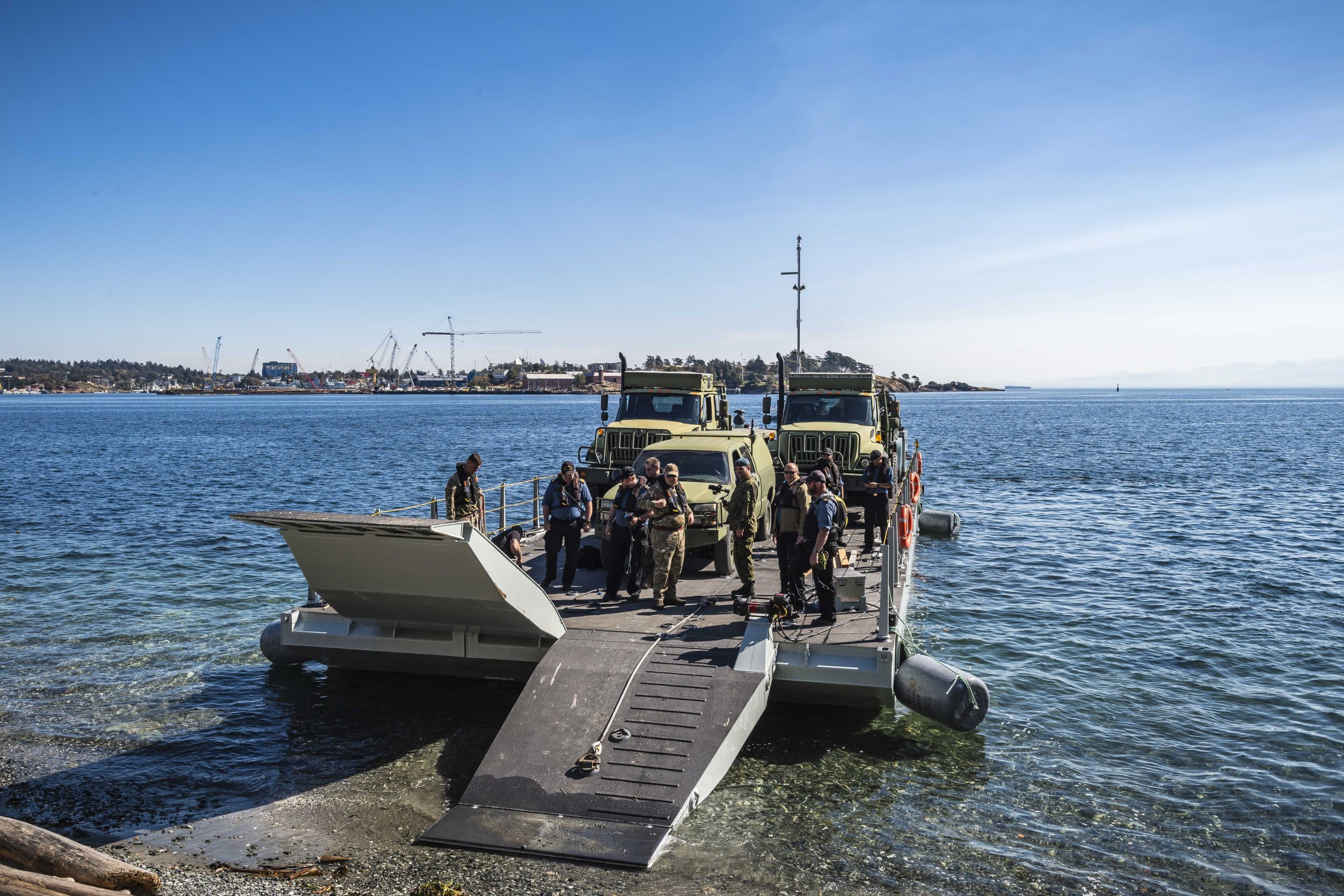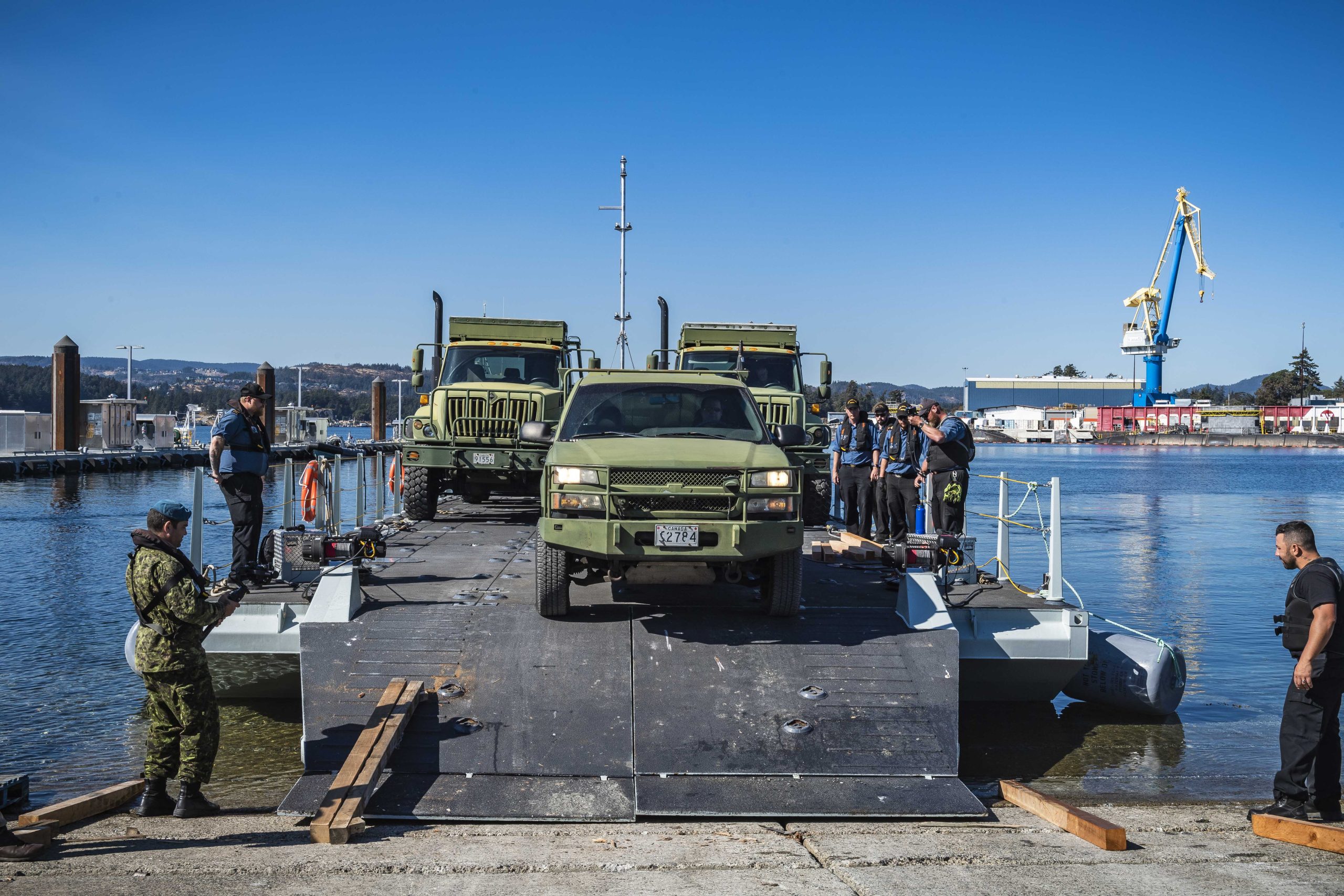New barges bring exciting capability to the Navy
By Lookout Production on Nov 08, 2022 with Comments 0

Canadian sailors train in Esquimalt, B.C., using the new sea-to-shore connector, a modular, self-propelled barge designed to support the future Joint Support Ships. Photo: Sailor First Class Kendric Grasby.
Royal Canadian Navy Public Affairs
—
A ground-breaking capability for the Royal Canadian Navy (RCN) is one step closer to reality.
A new phase of training for four modular, self-propelled barges designed to support the future Joint Support Ships (JSS) was recently completed.
Called sea-to-shore connectors, these barges can quickly move large quantities of mission-essential equipment, stores and personnel to and from shore, and can be stored or transported like standard shipping containers. Sea-to-shore connectors have multiple uses and configurations, and are engineered to be assembled from the JSS.
In October, 18 sailors, including Boatswains and Marine Technicians, concluded five weeks of collaborative training in Esquimalt, B.C., with instructors from the Defence College of Logistics, Policing and Administration in the United Kingdom (UK).
The Royal Navy has had a similar capability for over 60 years. The U.K. team could provide expert knowledge and advice about the new equipment – from myriad operational uses to technical repairs.
“We originally wanted help in using the sea-to-shore connector tactically, but we have tapped into the U.K.’s knowledge and opened a full Pandora’s Box in what can be done with them,” says Lieutenant-Commander (LCdr) Rowan Wilson, Executive Officer and Staff Officer, New Capability and Training at Naval Personnel and Training Group (NPTG) Headquarters. “We are just scratching the surface of this cool new capability and, hopefully, it will get more people excited about what the Navy does.”
The first of the four barges, built by Navamar of Montréal, has already been delivered to Esquimalt. Three more barges are expected over the next 12 months – two more on the West Coast and one on the East Coast.
LCdr Wilson is particularly enthused about the potential for a new, non-combat amphibious capability as the new barges can be driven right up to a beach with their roll-on-roll-off ramp extended if no dock or jetty exists.
“The collaborative training with the U.K. instructors showed us this is not just a new piece of equipment for the RCN, but an exciting return to a non-combat amphibious capability we haven’t had in decades,” LCdr Wilson said.
Petty Officer First Class (PO1) Shawn Beckett, a Boatswain for 29 years currently employed at the Naval Fleet School (Pacific) Seamanship Training Centre in Esquimalt, found working with instructors from the U.K. extremely beneficial thanks to their vast wealth of knowledge.
“They were also a fun group to work with, which made me feel part of a team, not just them as instructors and me as a student,” PO1 Beckett said. “I came to understand there is a lot that goes into preparing for and executing a beach landing. The barge with the right team will be a phenomenal asset to the RCN.”
While the sea-to-shore connector’s primary use is as a self-propelled barge that can travel up to five knots, it can also transform into a bridge, a floating dock, or a diving platform for salvage. In addition, it can be deployed as a standalone unit in support of humanitarian assistance, disaster relief or evacuation operations.
The barge’s engines, ramps and safety equipment will be stored in two 20-foot containers aboard the new JSS. The 12 pontoons can be stored like sea containers.
Master Sailor (MS) Christopher Cale, a Marine Technician who also took part in the recent training, said the U.K. team’s insight was critical in helping to repair one of the thrust modules when a leak developed in a propeller seal.
Until the JSS arrives in 2025, sailors will maintain skills by conducting periodic refresher training with the sea-to-shore connector, continuing collaborative training opportunities with the U.K., and plotting how the RCN can use the barges most effectively.
“When we talk about military capability, we envision personnel and equipment, but it’s the training that transforms these two elements into a capability,” said LCdr Wilson. “The sea-to-shore connector training will perpetuate itself through our institutions to enable future generations of sailors to operate the barges safely, competently and with confidence.”

Members of the Royal Canadian Navy’s initial training Cadre for the new Joint Support Ship’s Remotely piloted Landing Craft, receive training in pilotage, loading and unloading from members of the British Armed Forces in Esquimalt Harbour, Victoria B.C on 22 September 2022. Photo: Sailor 1st Class Kendric Grasby, MARPAC Imaging Services, Esquimalt
Filed Under: Top Stories
About the Author:





